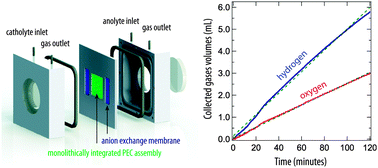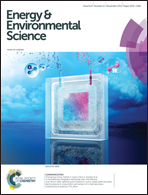A monolithically integrated, intrinsically safe, 10% efficient, solar-driven water-splitting system based on active, stable earth-abundant electrocatalysts in conjunction with tandem III–V light absorbers protected by amorphous TiO2 films†
Abstract
A monolithically integrated device consisting of a tandem-junction GaAs/InGaP photoanode coated by an amorphous TiO2 stabilization layer, in conjunction with Ni-based, earth-abundant active electrocatalysts for the hydrogen-evolution and oxygen-evolution reactions, was used to effect unassisted, solar-driven water splitting in 1.0 M KOH(aq). When connected to a Ni–Mo-coated counterelectrode in a two-electrode cell configuration, the TiO2-protected III–V tandem device exhibited a solar-to-hydrogen conversion efficiency, ηSTH, of 10.5% under 1 sun illumination, with stable performance for >40 h of continuous operation at an efficiency of ηSTH > 10%. The protected tandem device also formed the basis for a monolithically integrated, intrinsically safe solar-hydrogen prototype system (1 cm2) driven by a NiMo/GaAs/InGaP/TiO2/Ni structure. The intrinsically safe system exhibited a hydrogen production rate of 0.81 μL s−1 and a solar-to-hydrogen conversion efficiency of 8.6% under 1 sun illumination in 1.0 M KOH(aq), with minimal product gas crossover while allowing for beneficial collection of separate streams of H2(g) and O2(g).


 Please wait while we load your content...
Please wait while we load your content...